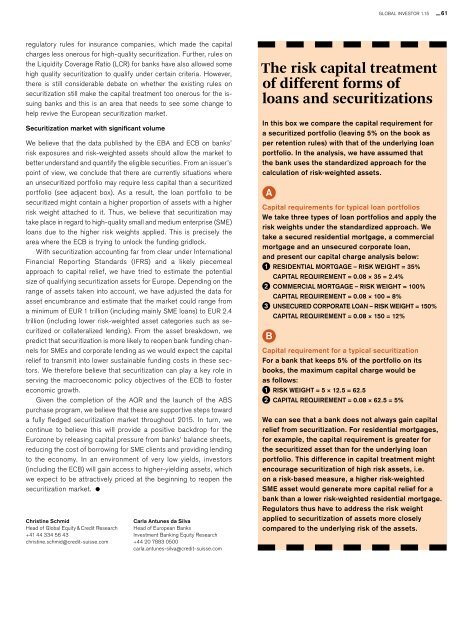Illiquid assets
Unwrapping alternative returns Global Investor, 01/2015 Credit Suisse
Unwrapping alternative returns
Global Investor, 01/2015
Credit Suisse
You also want an ePaper? Increase the reach of your titles
YUMPU automatically turns print PDFs into web optimized ePapers that Google loves.
GLOBAL INVESTOR 1.15 — 61<br />
regulatory rules for insurance companies, which made the capital<br />
charges less onerous for high-quality securitization. Further, rules on<br />
the Liquidity Coverage Ratio (LCR) for banks have also allowed some<br />
high quality securitization to qualify under certain criteria. However,<br />
there is still considerable debate on whether the existing rules on<br />
securitization still make the capital treatment too onerous for the issuing<br />
banks and this is an area that needs to see some change to<br />
help revive the European securitization market.<br />
Securitization market with significant volume<br />
We believe that the data published by the EBA and ECB on banks’<br />
risk exposures and risk-weighted <strong>assets</strong> should allow the market to<br />
better understand and quantify the eligible securities. From an issuer’s<br />
point of view, we conclude that there are currently situations where<br />
an unsecuritized portfolio may require less capital than a securitized<br />
portfolio (see adjacent box). As a result, the loan portfolio to be<br />
securitized might contain a higher proportion of <strong>assets</strong> with a higher<br />
risk weight attached to it. Thus, we believe that securitization may<br />
take place in regard to high-quality small and medium enterprise (SME)<br />
loans due to the higher risk weights applied. This is precisely the<br />
area where the ECB is trying to unlock the funding gridlock.<br />
With securitization accounting far from clear under International<br />
Financial Reporting Standards (IFRS) and a likely piecemeal<br />
approach to capital relief, we have tried to estimate the potential<br />
size of qualifying securitization <strong>assets</strong> for Europe. Depending on the<br />
range of <strong>assets</strong> taken into account, we have adjusted the data for<br />
asset encumbrance and estimate that the market could range from<br />
a minimum of EUR 1 trillion (including mainly SME loans) to EUR 2.4<br />
trillion (including lower risk-weighted asset categories such as securitized<br />
or collateralized lending). From the asset breakdown, we<br />
predict that securitization is more likely to reopen bank funding channels<br />
for SMEs and corporate lending as we would expect the capital<br />
relief to transmit into lower sustainable funding costs in these sectors.<br />
We therefore believe that securitization can play a key role in<br />
serving the macroeconomic policy objectives of the ECB to foster<br />
economic growth.<br />
Given the completion of the AQR and the launch of the ABS<br />
purchase program, we believe that these are supportive steps toward<br />
a fully fledged securitization market throughout 2015. In turn, we<br />
continue to believe this will provide a positive backdrop for the<br />
Eurozone by releasing capital pressure from banks’ balance sheets,<br />
reducing the cost of borrowing for SME clients and providing lending<br />
to the economy. In an environment of very low yields, investors<br />
(including the ECB) will gain access to higher-yielding <strong>assets</strong>, which<br />
we expect to be attractively priced at the beginning to reopen the<br />
securitization market.<br />
Christine Schmid<br />
Head of Global Equity & Credit Research<br />
+41 44 334 56 43<br />
christine.schmid@credit-suisse.com<br />
Carla Antunes da Silva<br />
Head of European Banks<br />
Investment Banking Equity Research<br />
+44 20 7883 0500<br />
carla.antunes-silva@credit-suisse.com<br />
The risk capital treatment<br />
of different forms of<br />
loans and securitizations<br />
In this box we compare the capital requirement for<br />
a securitized portfolio (leaving 5% on the book as<br />
per retention rules) with that of the underlying loan<br />
portfolio. In the analysis, we have assumed that<br />
the bank uses the standardized approach for the<br />
calculation of risk-weighted <strong>assets</strong>.<br />
A<br />
Capital requirements for typical loan portfolios<br />
We take three types of loan portfolios and apply the<br />
risk weights under the standardized approach. We<br />
take a secured residential mortgage, a commercial<br />
mortgage and an unsecured corporate loan,<br />
and present our capital charge analysis below:<br />
1 RESIDENTIAL MORTGAGE – RISK WEIGHT = 35%<br />
CAPITAL REQUIREMENT = 0.08 × 35 = 2.4%<br />
2 COMMERCIAL MORTGAGE – RISK WEIGHT = 100%<br />
CAPITAL REQUIREMENT = 0.08 × 100 = 8%<br />
3 UNSECURED CORPORATE LOAN – RISK WEIGHT = 150%<br />
CAPITAL REQUIREMENT = 0.08 × 150 = 12%<br />
B<br />
Capital requirement for a typical securitization<br />
For a bank that keeps 5% of the portfolio on its<br />
books, the maximum capital charge would be<br />
as follows:<br />
1 RISK WEIGHT = 5 × 12.5 = 62.5<br />
2 CAPITAL REQUIREMENT = 0.08 × 62.5 = 5%<br />
We can see that a bank does not always gain capital<br />
relief from securitization. For residential mortgages,<br />
for example, the capital requirement is greater for<br />
the securitized asset than for the underlying loan<br />
portfolio. This difference in capital treatment might<br />
encourage securitization of high risk <strong>assets</strong>, i.e.<br />
on a risk-based measure, a higher risk-weighted<br />
SME asset would generate more capital relief for a<br />
bank than a lower risk-weighted residential mortgage.<br />
Regulators thus have to address the risk weight<br />
applied to securitization of <strong>assets</strong> more closely<br />
compared to the underlying risk of the <strong>assets</strong>.

















